Home
Catalog
African
Age of Reason
Alchemy
Americana
Ancient Near East
Asia
Atlantis
Australia
Basque
Baha'i
Bible
Buddhism
Celtic
Christianity
Classics
Confucianism
DNA
Earth Mysteries
Egyptian
England
Esoteric/Occult
Evil
Fortean
Freemasonry
Gothic
Gnosticism
Grimoires
Hinduism
I Ching
Islam
Icelandic
Jainism
Journals
Judaism
Legends/Sagas
LGBT
Miscellaneous
Mormonism
Native American
Necronomicon
New Thought
Neopaganism/Wicca
Nostradamus
Oahspe
Pacific
Paleolithic
Philosophy
Piri Re'is Map
Prophecy
Roma
Sacred Books of the East
Sacred Sexuality
Shakespeare
Shamanism
Shinto
Sikhism
Sub Rosa
Swedenborg
Sky Lore
Tantra
Taoism
Tarot
Thelema
Theosophy
Time
Tolkien
UFOs
Utopia
Women
Zoroastrianism
Esoteric Evil

|
Gothic Texts |
Gothic refers to a Romantic literary style which can include supernatural aspects, particularly vampires. This is because many of these stories are set in locales with Gothic architecture. This page includes significant non-fiction and fiction books about vampires and related subjects.
Why cover this subject at sacred-texts? From Lord Byrons' literary circle to Buffy the Vampire Slayer, vampires and their kin have evolved into a modern mythology about the presence of evil in a world governed by science. Gothic literature is an outlet for the ancient fears of humanity in an age of reason. These texts allow us to trace the evolution of this mythology.
Gothic literature shouldn't be confused with texts in the Gothic language, the earliest written Germanic language, which includes the Codex Argentius, a translation of parts of the New Testament. For more information, we recommend Database of the Gothic Language [External Site].
The Vampire, his Kith and Kin,
by Montague Summers. [1928]
Summers, a devout and very literal Catholic,
was apparently convinced of the reality of the undead.
This work is a serious, often pedantic, academic review of the literature.
However, it is required reading for any prospective vampire experts.
(An Internet rumor has it that Buffy
Summers got her last name from this author; we welcome any
comments on whether there is any truth to this.)
This etext was scanned at sacred-texts.
The Book of Were-Wolves,
by Sabine Baring-Gould. [1865]
All killer, some filler.
This is one of the best known studies of lycanthropy,
written by the author of the hymn 'Onward Christian Soldiers.'
The first ten chapters are a pretty good review of the shape-shifting
literature, and then it takes a strange
left turn into the topic of psychopathy.
This etext was scanned at sacred-texts.
Frankenstein
by Mary Wollstonecraft Shelley [1818]
It's alive!
This modern reworking of the Golem story
is a cautionary tale about science.
Frankenstein just keeps getting more relevant as we
stumble forward into the 21st Century of clones, stem cells and
genomics.
Mary Wollstonecraft Shelley, along with her husband,
the poet Percy Bysshe Shelley, was a member of Lord Byron's circle;
her mother, Mary Wollstonecraft,
wrote one of the key feminist documents,
Vindication of the Rights Of Woman
(also at this site).
The Vampyre,
by John Polidori [1819]
Originally spuriously attributed to Lord Byron,
this was actually written by Dr. John
William Polidori, a physician friend of Lord Byron.
The main character of Ruthven is reputedly based on Byron.
This short novel caused a sensation at the time, and spawned
a vampire craze, with numerous books and plays based on
or imitating its story line.
For more information, refer to Chapter V of The Vampire, his Kith and Kin.
Dracula
by Bram Stoker [1897]
Dracula, not Ruthven, is the template for the modern vampire craze.
This novel, in the form of fictional journals and letters,
was not the first or even the best 19th Century vampire tale,
but is today the best known, due to the endless number of movies based on it.
Today we know that Dracula had a medieval counterpart, Vlad the Impaler,
who lived in Wallachia (which is to the south of Transylvania),
today part of Romania.
Although not an actual vampire, Vlad was said to
have spilled quite a bit of blood in his day.
Lair of the White Worm by Bram Stoker [1911]. This novel, also by Bram Stoker, is an erotic thriller of demonic possession, this time by a giant invertebrate. It was made into a dreadful movie by Ken Russell, which has become something of a cult classic. Note that there are racist terms and characterizations in in this book, so be forewarned.
Vikram and The Vampire,
translated by Sir Richard R. Burton. [1870]
This collection of Hindu fables, which has an Arabian Nights-style
backstory with a legendary Indian monarch playing Scheherazade to
an undead being,
doesn't have much to do with vampires, but this seemed
the best place to put it.
Burton, as it happens, also translated the
Arabian Nights.
Links to other Burton material at sacred-texts
(most not suitable for children) can be found in the
Kama Sutra section.
Psychic Vampires
The Vampire Codex
by Michelle Belanger.
There are Vampires among us.
Ms. Belanger has graciously donated this text
which describes her beliefs on this topic.
The Vampire Ritual Book
by Michelle Belanger. [2003]